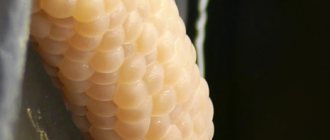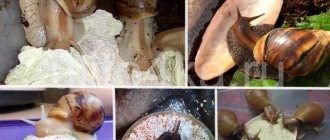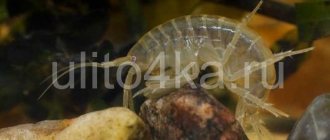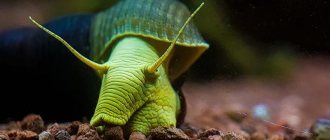All snails are vegetarians. Therefore, the question of what you can feed snails implies that the diet will be based on fiber. Three main components of the diet of domestic Achatina, on which the health of the pet depends:
- fiber sources;
- vegetable proteins;
- mineral supplements.
The main food is fruits and vegetables and lettuce. Achatina eat all kinds of herbs with pleasure, including if they grow right in their terrarium.
Buy your pet a large and beautiful house inexpensively and sow various herbs, moss and cereals there. And your pet will be happy.
Before feeding snails, all permitted products are washed well with running water without using detergents. Loving owners of Achatina should remember that the health of the snail depends on how balanced the menu is.
Feeding mode
Breeders believe that if we are talking about the growing body of a young Achatina, then it needs to be fed daily. And the hatched little snails are even fed several times a day so that they do not lag behind in development. Adult snails can go without food for two to three days. It is believed that Achatina herself will let you know when she is full. Here are just a few signs when you need to stop feeding your pet:
- refusal of food;
- sluggish and reluctant eating;
- a large amount of food remains on the plate.
Domestic snails Achatina, like mammals, have food preferences. Some owners have noticed more than once how the snail refused, for example, cabbage in favor of a cucumber or banana. Taste habits can change with age. Young snails love living vegetation, while adults love rotting roots.
Conclusion: you need to feed your domestic Achatina with a variety of foods, but not spoil the animal.
List of approved products
The list of what you can feed Achatina snails is wide, despite the lack of animal proteins in it:
- berries (strawberries, cherries, cherries, wild strawberries);
- greens (lettuce, dill, spinach, celery, plantain);
- fruits (peaches, pears, apples, bananas, apricots, kiwi);
- vegetables (zucchini, cucumber, tomatoes, peppers, all types of cabbage, carrots, legumes).
The most popular foods for snails are cucumbers, lettuce, zucchini and bananas.
In addition to fiber, Achatina snails can be fed with vegetable protein:
- nuts;
- milk;
- sour cream;
- Hercules;
- raw mushrooms;
- oatmeal;
- pet food.
As a source of calcium, you will need dietary supplements such as cuttlefish shell, chalk, eggshells or shell rock. Minerals are poured in small quantities onto a plate on top of the main food.
Interesting fact: with the help of diet you can influence the color of the shell of the domestic Achatina. If from childhood you feed Achatina with foods of bright colors, such as tomatoes or carrots, the shell will acquire bright, beautiful shades.
Vegetables, fruits and mushrooms should be served to the snails on a “plate” made of lettuce. It is better to feed snails with coarsely chopped products. Fresh aromas immediately attract Achatina. They are active and, due to their numerous teeth, easily cope with products of different hardness and consistency. It is better to feed young domestic Achatina with grated carrots and other vegetables, but do not grind the fruits into liquid puree, as the babies will not eat it, but may choke or suffocate in the soft mass.
There is no need to cook anything for snails! High temperatures kill beneficial vitamins in fresh plants. Even cereals, minced meat, and Achatina oatmeal are eaten ground to powder form, but without harmful heat treatment.
Prohibited foods in the diet
The following list will clearly demonstrate what you should not feed Achatina snails. These products are dangerous to the health and life of pets, and most importantly, they can lead to their death or painful, protracted illnesses. Prohibited products include:
- Salt is the white death of the Achatina snail! A few grains of salt can kill 2-3 babies and an adult.
- Food from the people's table! Domestic snails should not eat anything fried, spicy, pickled, sweet or smoked. It is forbidden to feed even on trial, even as an experiment.
- Pasta and any flour products will lead to death. The snail will not be able to digest such heavy food.
- It is not recommended to feed Achatina eggs, even boiled, due to salmonellosis. However, some breeders pamper their pets with this valuable protein product.
- Bitter, hot and sour vegetables are prohibited - onions, garlic, radishes, sorrel, wormwood, tomato tops.
- Citrus fruits are not recommended due to their high acid content.
- It is not advisable to feed potatoes even when boiled!
- Semolina swells greatly and absorbs water, making it difficult for weak, delicate Achatina to digest.
From the two lists given, we can conclude what can and cannot be fed to Achatina snails and how to create a complete daily diet. But it will not be complete without mineral supplements that will provide the delicate Achatina with vital microelements.
Greenery
The greens that are present in the human diet can number dozens of items. Its most popular types are:
- parsley,
- spinach,
- dill,
- basil,
- green onions,
- sorrel,
- celery, etc.
But not every herb on this list is suitable for a snail, whose digestive system is highly sensitive.
What grass can you give to snails? The most popular among shellfish are the leaves of various salads. These plants are characterized by a high content of substances such as:
- calcium,
- copper,
- iron,
- magnesium,
- zinc,
- chrome, etc.
And their leaves also contain a whole list of vitamins (A, B, C, E, K, PP, H) necessary for the body of the gastropod.
Is it possible for snails to have parsley, dill, sorrel, we will look in more detail.
Parsley (greens) contains a large percentage of carotene, apigenin, luteolin, vitamins C, B, K, PP and provitamins A and B. Folic acid, phosphorus, potassium, magnesium, iron are all substances necessary for snails. Therefore, parsley must be present in their diet.
Dill is considered one of the most common garden plants. This fragrant herb is rich in vitamin C, carotene, nicotinic and folic acid. Dill contains many valuable microelements (calcium salts, phosphorus, iron, etc.). Snails need such greens for daily nutrition.
Sorrel contains oxalic acid. Therefore, it is not recommended to give it to snails. This is one of the few herbs that can cause a negative body reaction in a pet.
Calcium is an essential element for life and reproduction
During the period of growth and development, as well as for the birth of full-fledged and healthy offspring, Achatina especially needs calcium. The daily diet of African Achatina must include mineral supplements and calcium-containing foods. They are fed as powders or additional toppings for fresh vegetables and fruits.
It is recommended to use the following as permanent mineral supplements:
- Eggshells, feed chalk, cuttlefish shell, shell rock;
- Healthy cereals - rice, millet, oats, buckwheat, bran;
- Daphnia fish food or other high-quality food.
Read more about the use of chalk and sepia in the diet of Achatina snails.
The solid ingredients must be ground in a coffee grinder and then mixed in an airtight container with a lid. Before grinding, the shells of raw eggs must be doused with boiling water and thoroughly dried. Achatina should be fed with this healthy flour at each feeding in the form of an appetizing sprinkle on pieces of apples, pears, cucumbers and other fresh plants.
Important! It is necessary to ensure that the powder is perfect, without pieces of hard shells or large food granules. For the delicate insides of Achatina, any sharp, hard particles are extremely dangerous.
Feeding snails in winter
During the ripening period of fresh vegetables and fruits, you can feed Achatina without problems. They are voracious and even eat plant food waste. But in winter, the variety of fresh plants sharply decreases and owners have to rack their brains about what to feed the African Achatina snails, lovers of juicy vegetables and fruits.
Experienced breeders recommend:
- Lean on grain grinding - process buckwheat, rice, pearl barley into flour.
- Pumpkin, carrots, cucumbers, zucchini, squash, turnips, bananas and apples are among the available and inexpensive products all year round. You can feed Achatina in a variety of ways, making mixtures of their cereals, mineral supplements and various vegetables, changing the composition every day.
- If possible, add pure cottage cheese without harmful additives to the diet 1-2 times a week; snails eat it with great pleasure;
- It is recommended to grow your own greens and lettuce in pots in winter to the delight of your beloved Akhatina plants.
- For variety, you can give chicken meat, baby vegetable purees and cereals.
Achatina are real gourmets! The natural freshness of plants and a rich variety of vitamins are important for their diet. But snails are predatory and voracious, so their diet can be varied with dried plankton from fish food. Additionally, it is advisable to add rotten algae and aquarium plants; they will become a real feast for Achatina during fasting vegetarian days.
Basic moments
The diet of a domestic snail must include a variety of vegetable plants. This is especially important in winter, when there is a lack of fresh, lush greenery.
Before you find out what vegetables the Achatina snail eats, it is worth familiarizing yourself with the main rule: all plant products that the animal will eat must be grown on its own plot. If you buy them in the supermarket in winter, the snail runs the risk of being poisoned by various chemicals.
Read on to find out whether snails can eat melon, cucumbers, watermelon, tomatoes, eggplant, carrots and what other vegetables can be given to snails.
Principles of organizing proper nutrition for African Achatina
There are basic principles of snail nutrition that apply to all species:
- Achatina’s daily diet should include a variety of plants;
- Important animal proteins supplement the snails' main diet;
- The third mandatory component of the diet of Achatina snails is mineral feeding.
The nutrition of African Achatina snails at home is based on these three basic principles. A constant lack of one of the components will lead to illness in the tender snail and its possible death.
The African snail Achatina in its natural habitat prefers leaves and grass, tree bark and juicy tropical fruits. It seems that Achatina are real gourmets, they can eat fresh herbs and immediately snack on half-rotten berries. Certain species of Achatina consider fallen rotting wood a real delicacy and can eat it entirely in a huge colony without leaving a trace. As you know, snails have many teeth, they are quite voracious, often attack large plantations of cultivated plants and in a short time cause irreparable damage to farming.
On a note! Any human food, bread and other flour products are strictly contraindicated for domestic snails.
Under no circumstances should cut up newspapers be placed in the aquarium of domestic snails as bedding. Eating paper, especially with printed font, will lead to the death of pets. And, most importantly, the tender Achatina is very afraid of grains of salt. They corrode their thin skin and burn their insides. Half a teaspoon of salt can kill an entire herd of defenseless snails!
It is not advisable to include citrus fruits and other sour fruits in the daily diet of Achatina snails. Any strong acids negatively affect the digestion and vital functions of Achatina. These foods are not strictly prohibited; they can be given in limited quantities and the reaction and condition of the snails can be monitored.
How often should you water clams?
Water is the source of life for African snails. It helps maintain body temperature, digest vitamins and minerals, remove toxins from the body, and produce protective mucus.
It is important to give the Achatina snails the opportunity to quench their thirst every time after feeding. For these purposes, you can purchase a spray bottle: mollusks love to drink, licking drops of water from the walls of the terrarium. To avoid dehydration of Achatina, you should regularly moisten the soil in the terrarium and keep a saucer of clean water at room temperature.
Shellfish need water to live.
It is important to choose a container with low sides. Otherwise, the clam may choke. Do not use regular tap water. Its high chlorine content is dangerous for snails. Boiled, filtered, bottled water is suitable for Achatina.
Variety and mode
Domestic snails need protein food for normal growth and reproduction. Once or twice a week you can pamper them with thoroughly ground minced meat and meat and bone meal.
Calcium is also vital for growing and pregnant snails. To do this, you need to put chalk, crushed eggshells in the aquarium, or buy a special sepia supplement - a mineral stone for birds.
If calcium is purchased at a pharmacy, it must be pure without sodium or other additives.
There are several important points in organizing Achatina’s nutrition:
- The feeding of domestic Achatina snails should be regular.
- It is better to serve food on a plate or on a leaf of lettuce once a day in the evening.
- Young snails should have food available at all times, but it is important to ensure that it does not spoil and that insects do not infest it.
- It is advisable to serve soft vegetables and fruits in pieces, and grind hard ones into a paste.
- Water should be constantly available, but the level in the drinking bowl should not exceed a height of 1 cm.
The diet of all types of domestic snails depends on the location of the breeder and seasonal plants. Nutrition can be based on the characteristics of the species and the preferences of the Achatina itself. The main thing is to exclude prohibited foods, and other vegetables, fruits and herbs can be given to the snail without restrictions. Achatina will decide for herself what she likes best and what products will benefit her growth, development and reproduction.
How to properly collect, dry and freeze herbs for the winter
- collect plants away from roads and railways;
- choose whole and green leaves;
- Wash the herbs thoroughly under cold water or soak them in water for 20 minutes;
- then dry and place on paper;
- if you decide to freeze herbs, chop them up and put them in bags and put them in the freezer;
- To dry, it is enough to leave the herbs to dry for 3-4 weeks;
- If dried herbs crumble in your hands, they can be placed in dry jars or old pillowcases.











